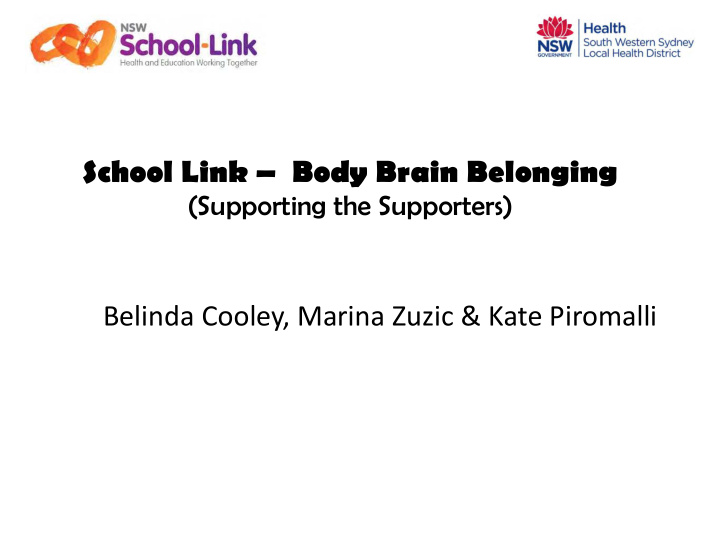



School Link – Body Brain Belonging (Supporting the Supporters) Belinda Cooley, Marina Zuzic & Kate Piromalli
South Western Sydney Local Health District (SWSLHD) Covering the Local Government areas: Cam den Cam pbelltow n Fairfield Liverpool W ingecarribee W ollondilly 3 0 0 + Schools
School Link SWSLHD who we are & where we are going…
Body Brain Belonging ‘Decades of research have shown that self-regulation is the foundation of healthy human development; adaptive coping skills; positive parenting; learning; safe and caring schools; and vibrant communities. ’ Dr Stuart Shanker, The Mehrit Centre
Current SL Core business & Projects • Clinical consultation • School Link Talks • School Link magazine • Holiday z cards • LGBTI Fact Sheet & Guidelines • Professional development @ schools • Upcoming resource (BBB)
Professional Development
Consulting Service Phone our School Link Team for a brainstorm and advice. Common consult themes: • Developmental Trauma • Suicidal ideation/attempts Drug & alcohol use • • Sexualised Behaviours • Personality Disorders • Self Harm • Externalising behaviours: aggression, defiance, etc. Internalising behaviours including childhood • anxiety and depression • LGBTI related issues • Disordered eating
Our new resource
What do we want to avoid? Reactive responses Waiting for a crisis before planning Isolating the young person Exclusion from school
‘Stigma hasn’t left the building’ P5 Responding to Mental Health Complexities
The Quest for a Mental Health Clearance Letter No clinician is able to guarantee or predict risk beyond the consultation room ie Discharged from emergency, considered safe to be in the community & participating in daily activities (which includes school).
Supporting the well-being of children: What are the challenges?
Supporting the mental health of all students Whole school & Targeted Approaches (Beyond individual students)
School connectedness Belonging Resilience
Ideas for helping a student to belong • What are their interests? • Which staff member do they have the greatest connection with? • What do their peer relationships look like? • What have their experiences of belonging been outside of the school setting (family, community)? • Who and where can we link them in? Matching their interests • • Connections in different settings
Belonging through co-curricular activities
Responding to a mental health crisis
Brain & Behaviour in a Crisis Brainstem: survival system Limbic brain: emotional system Cortical brain: thinking system
Responding in a crisis The brain: Where are they operating from BRAIN STEM – survival mode Drink of water Change of body position Change of environment (inside/outside) Move to a quiet space Less visually stimulating Less fluoro lighting. Do they need to sit or walk? Use a calm, reassuring tone Avoid over-talking, over-explaining
LIMBIC SYSTEMS – emotional mode Validate the emotion eg you seem really upset Find a person who the student connects with to be with them during this time Avoid time-out CORTICAL BRAIN – higher order thinking After considering the physical/safety and emotional needs… Support for student to cognitively reflect experience & student to suggest alternatives
Writing a Support Plan
When developing a plan consider: Brain: - Do we need strategies/adjustments to be: Cognitive? Emotionally calming? Regulating? Body: - What specific regulating strategies may be needed considering the specific to student’s needs? Belonging: - Who do they connect with? - What activities help them feel more connected to school; - what additional opportunities could build on this interest/strength/value?
Child Protection • Ensure child protection screening occurs when mental health difficulties occur. • Child abuse and/or attachment compiexities are a significant risk factor for a range of mental illnesses.
Responding to Mental Health Complexities- The Role of Schools • Actively working towards creating a sense of belonging, connection & safety at school. • Having an individualised plan including adjustments for students who are managing mental health challenges. • Focusing on the whole student – beyond a diagnosis
Contacts Belinda Cooley Ph - 9616 4265 E-mail: belinda.cooley@sswahs.nsw.gov.au Marina Zuzic Ph – 9616 4257 E-mail: marina.zuzic@sswahs.nsw.gov.au Kate Piromalli Ph: 9616 4255 Email: kate.piromalli@sswahs.nsw.gov.au Infant Child Adolescent Mental Health Service www.icamhs.com.au Consultation Mobile – 0484 334 227
School Link – statewide contacts www.nswschool-link.com
Coming Soon..... Body, Brain, Belonging- The Story of Behaviour (Resource for Schools) 31
Recommend
More recommend